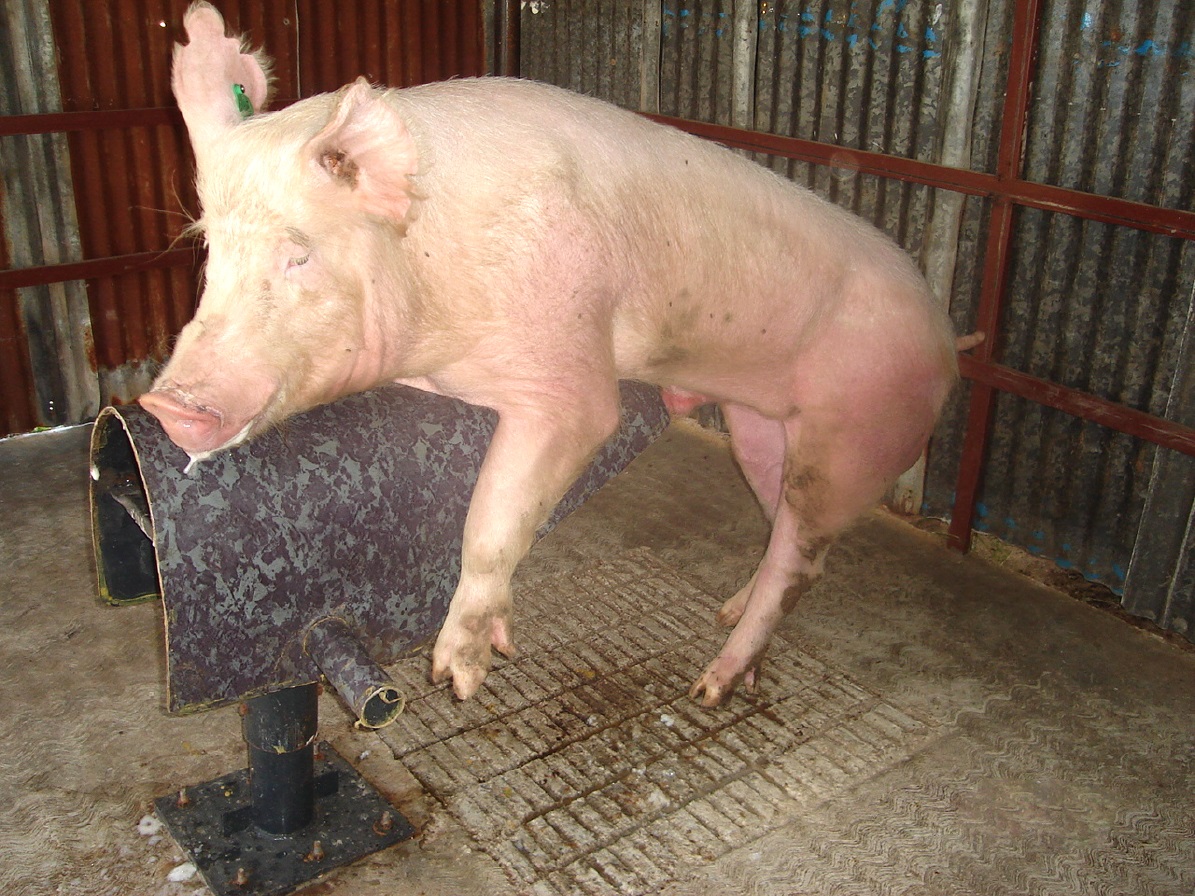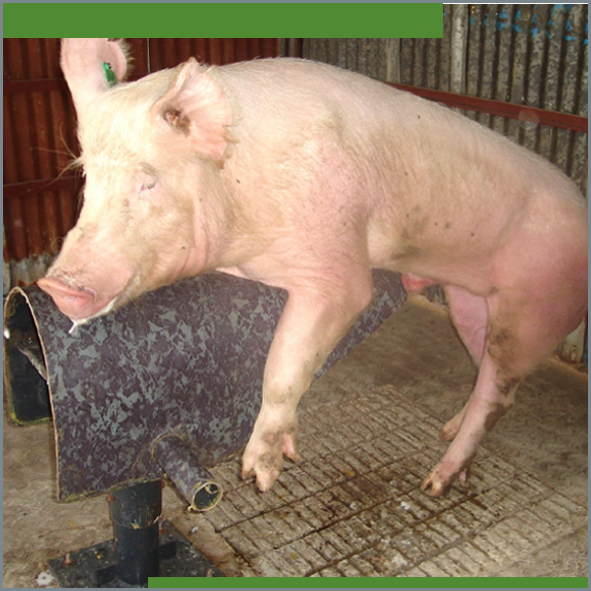Conjugated linoleic acid supplementation does not improve boar semen quality and does not change its fatty acid profile
Main Article Content
Abstract
Veterinaria México OA
ISSN: 2448-6760
Cite this as:
- Zamora-Zamora V, Figueroa-Velasco JL, Cordero-Mora JL, Nieto-Aquino R, García-Contreras AC, Sánchez-Torres MT, Carrillo-Domínguez S, Martínez-Aispuro JA. Conjugated linoleic acid supplementation does not improve boar semen quality and does not change its fatty acid profile. Veterinaria México OA. 2017;4(3). doi: 10.21753/vmoa.4.3.387.
The aim of this study was to evaluate the effects of adding conjugated linoleic acid (CLA) to boar diets on semen producion and characteristics, the fatty acid profile of spermatozoa, and on testicle and boar carcass parameters. Ten lean-type terminal-line (Yorkshire x Landrace x Petrain) adult boars were randomly assigned to one of two treatments: (1) a control diet and (2) the same diet with 1% CLA. The research was conducted in Mexico, and the animals were exposed to ambient temperatures betwen 13.5 and 26.3 °C. Boars were ejaculated twice per week a 12-week period to examine semen production and characteristics. The results suggest that supplementation of boar diets with CLA did not affect the spermatozoa fatty acid profile, semen volume, sperm concetration, viability, or motility, nor did it cause abnormal sperm morphology. Compared to controls, boar fed a CLA diet had a higher seminal pH and increased backfat thickness. In summary, this study indicates that CLA addition in boar diet does not change the semen characteristics of fatty acid profile of spermatozoa; however, it increases backfat thickness in sexually mature boars.

Article Details
References
Liu Q, Zhou YF, Duan RJ, Wei HK, Jiang SW, Peng J. Effects of dietary n-6:n-3 fatty acid ratio and vitamin E on semen quality, fatty acid composition and antioxidant status in boars. Anim Reprod Sci. 2015;165:11-9. doi: 10.1016/j.anireprosci.2015.08.012.
Webel SK, Spencer JD, Gaines AM. The role of omega-3 and omega-6 fatty acids in swine reproduction. J Anim Sci. 2007;85:401.
Wathes D, Abayasekara D, Aitken R. Polyunsaturated fatty acids in male and female reproduction. Biol Reprod. 2007;77:190-201. doi: 10.1095/biolreprod.107.060558.
Maldjian A, Pizzi F, Gliozzi T, Cerolini S, Penny P, Noble R. Changes in sperm quality and lipid composition during cryopreservation of boar semen. Theriogenology. 2005;63:411–21.
Esmaeili V, Shahverdi AH, Moghadasian MH, Alizadeh AR. Dietary fatty acids affect semen quality: a review. Andrology. 2015;3:450–61.
Strze˙zek J, Fraser L, Kukli´nska M, Dzieko´nska A, Lecewicz M. Effects of dietary supplementation with polyunsaturated fatty acids and antioxidants on biochemical characteristics of boar semen. Reprod Biol. 2004;4:271-87.
Lin Y, Cheng X, Mao J, Wu D, Ren B, Xu S, et al. Effects of different dietary n-6/n-3 polyunsaturated fatty acid ratios on boar reproduction. Lipids Health Dis. 2016;15:31. doi: 10.1186/s12944-016-0193-8.
Estienne MJ, Harper AF, Crawford RJ. Dietary supplementation with a source of omega-3 fatty acids increases sperm number and the duration of ejaculation in boars. Theriogenology. 2008;70:70-6.
Pariza MW, Park Y, Cook ME. The biologically active isomers of conjugated linoleic acid. Prog Lipid Res. 2001;40:283-98.
Park Y, Storkson JM, Albright KJ, Liu W, Pariza MW. Evidence that the trans-10, cis-12 isomer of conjugated linoleic acid induces body composition changes in mice. Lipids. 1999;34(3):235-41.
Nicolosi R, Rogers EJ, Kritchevsky D, Scimeca JA, Huth PJ. Dietary conjugated linoleic acid reduces plasma lipoproteins and artery aortic atherosclerosis in hypercholesterolemic hamsters. Artery. 1997;22:266-77.
Moloney F, Toomey S, Noone E, Nugent A, Allan B, Loscher CE, et al. Antidiabetic effects of cis-9, trans-11-conjugated linoleic acid may be mediated via anti-inflammatory effects in white adipose tissue. Diabetes. 2007;56:574-82. doi: 10.2337/db06-0384.
Kelley DS, Erickson KL. Modulation of body composition and immune cell functions by conjugated linoleic acid in humans and animal model: benefits vs. risks. Lipids. 2003;38(4):377-86. doi: 10.1007/s11745-003-1072-2.
Hur SJ, Park GB, Joo ST. A comparison of the effects of dietary conjugated linoleic acid contents, cholesterol, lipid oxidation and drip loss in pork loin and chicken breast. J Muscle Foods. 2007;18:264-75. doi: 10.1111/j.1745-4573.2007.00082.x.
Ostrowska E, Muralitharan M, Cross RF, Bauman DE, Dunshea FR. Dietary conjugated linoleic acids increase lean tissue and decrease fat deposition in growing pigs. J Nutr. 1999;129(11):2037-42.
Martínez-Aispuro M, Figueroa-Velasco JL, Zamora-Zamora V, Cordero-Mora JL, Narciso-Gaytán C, Sánchez-Torres MT, et al. Effect of CLA supplementation to low-protein diets on the growth performance, carcass characteristics, plasma urea nitrogen concentration, and fatty acid profile in the meat of pigs. Braz Arch Biol Technol. 2014;57(5):742-54. doi: 10.1590/S1516-8913201401407.
Ivanovic J, Pantic S, Dokmanovic M, Glamoclija N, Markovic R, Janjic J, et al. Effect of conjugated linoleic acids in pig nutrition on quality of meat. Procedia Food Sci. 2015;5:105-8. doi: 10.1016/j.profoo.2015.09.029.
Hadaš Z, Nevrkla P, Václavková E. Effect of conjugated linoleic acid on reproductive performance of gilts. J Agricultural Sci.7(6):120-6. doi: 10.5539/jas.v7n6p120.
Castañeda-Gutiérrez E, Benefield BC, de Veth MJ, Santos NR, Gilbert RO, Butler WR, et al. Evaluation of the mechanisms of action of conjugated linoleic acid isomer on reproduction in dairy cows. J Dairy Sci. 2007;90(9):4253-64. doi: 10.3168/jds.2007-0117.
Council for International Organizations of Medical Sciences. International Guiding Principles for Biomedical Research Involving Animals. Geneva (CH)1986.
Secretaría de Gobernación. [NOM-062-ZOO] Norma Oficial Mexicana. Especificaciones técnicas para la producción, cuidado y uso de los animales de laboratorio. México DF (MX): Diario Oficial de la Federación; 1999.
[NRC] National Research Council. Nutrient Requirements of Swine. 10th ed. Washington DC (US): National Academy Press; 1998.
Hancock JL, Hovell GJR. The collection of boar semen. Vet Rec. 1959;71:664-5.
Ax RL, Dally MR, Didion BA, Lenz RW, Love CC, Varner DD, et al. Semen evaluation. In: E HES, B H, editors. Reproduction in farm animals. 7th ed. Baltimore (US): Wiley-Blackwell; 2000. p. 365-75.
Rodriguez-Gil JE, Rigau T. Effects of slight agitation on the quality of refrigerated boar semen. Anim Reprod Sci. 1995;39:141-6.
Tardif S, Laforest JP, Cornier N, Bailey JL. The importance of porcine sperm parameters on fertility in vivo. . Theriogenology. 1999;52:447-59.
Sorensen AM. Animal Reproduction: Principles and Practices. New York (US): McGraw-Hill Publishing Co; 1979.
Association of Official Analytical Chemists International. Official Methods of Analysis of AOAC International. 17th ed. Gaithersburg MD (US)2000.
Association of Official Analytical Chemists. Official Methods of Analysis. 15th ed. Washington D C (US)1990.
Tejada HI. Análisis de granos y cereales. Control de Calidad y Análisis de Alimentos para Animales. México (MX): Sistema de Educación Continúa en Producción Animal, A.C.; 1992.
Fick KR, McDowell LR, Miles RH, Wilkins NS, Funk J, Conrad JH. Methods of Mineral Analysis of Plant and Animal Tissues. 2nd ed. Gainesville, FL (US): University of Florida; 1979.
SAS Institute. The SAS System, release 8.2 for Windows. North Carolina (US): Cary; 2009.
Steel RG, Torrie JH, Dickey DA. Principles and procedures of statistics: A biometrical approach. 3rd ed. New York (US): WCB McGraw-Hill Co; 1997.
França LR, Avelar GF, Almeida FFL. Spermatogenesis and sperm transit through the epididymis in mammals with emphasis on pigs. Theriogenology. 2005;63:300-18.
Paulenz H, Taugbøl O, Hofmo P, Saarem K. A preliminary study on the effect of dietary supplementation with cod liver oil on the polyunsaturated fatty acid composition of boar semen. Vet Res Commun. 1995;19:273-84.
Castellano CA, Audet I, Bailey JL, Chouinard PY, Laforest JP, Matte JJ. Effect of dietary n-3 fatty acids (fish oils) on boar reproduction and semen quality. J Anim Sci. 2010;88(7):2346-55. doi: 10.2527/jas.2009-2779.
Ciereszko A, Ottobre JS, Glogowski J. Effects of season and breed on sperm acrosin activity and semen quality of boars. Anim Reprod Sci. 2000;64(1-2):89-96.
Larsson K, Einarsson S. Seminal changes in boars after heat stress. Acta Vet Scandinavica. 1984;25:57-66.
Yeste M, Barrerab X, Collc D, Boneta S. The effects on boar sperm quality of dietary supplementation with omega-3 polyunsaturated fatty acids differ among porcine breeds. Theriogenology. 2011;76(1):184-96. doi: 10.1016/j.theriogenology.2011.01.032.
J AR. Free radicals, lipid peroxidation and sperm function. Reprod Fertil Dev. 1995;7:659-68.
Lauridsen C, Mu H, Henckel P. Influence of dietary conjugated linoleic acid (CLA) and age at slaughtering on performance, slaughter- and meat quality, lipoproteins, and tissue deposition of CLA in barrows. Meat Sci. 2005;69(3):393-9. doi: 10.1016/j.meatsci.2004.08.009.
Tous N, Lizardo R, Vilà B, Gispert M, Font-i-Furnols M, Esteve-Garcia E. Effect of a high dose of CLA in finishing pig diets on fat deposition and fatty acid composition in intramuscular fat and other fat depots. Meat Sci. 2013;93:517-24. doi: 10.1016/j.meatsci.2012.10.005.
Surai PF, Noble RC, Sparks NH, Speake BK. Effect of long-term supplementation with arachidonic or docosahexaenoic acids on sperm production in the broiler chicken. J Reprod Fertil. 2000;120(2):257-64.
Qi R, Yang F, Huang J, Peng H, Liu Y, Liu Z. Supplementation with conjugated linoleic acid decreases pig back fat deposition by inducing adipocyte apoptosis. BMC Vet Res. 2014;10:141. doi: 10.1186/1746-6148-10-141.
Mirand PP, Arnal-Bagnard MA, Mosoni L, Faulconnier Y, Chardigny JM, Chilliard Y. Cis-9, trans-11 and trans-10, cis-12 conjugated linoleic acid isomers do not modify body composition in adult sedentary or exercised rats. J Nutr. 2004;134:2263-9.
License

Veterinaria México OA by Facultad de Medicina Veterinaria y Zootecnia - Universidad Nacional Autónoma de México is licensed under a Creative Commons Attribution 4.0 International Licence.
Based on a work at http://www.revistas.unam.mx
- All articles in Veterinaria México OA re published under the Creative Commons Attribution 4.0 Unported (CC-BY 4.0). With this license, authors retain copyright but allow any user to share, copy, distribute, transmit, adapt and make commercial use of the work, without needing to provide additional permission as long as appropriate attribution is made to the original author or source.
- By using this license, all Veterinaria México OAarticles meet or exceed all funder and institutional requirements for being considered Open Access.
- Authors cannot use copyrighted material within their article unless that material has also been made available under a similarly liberal license.



